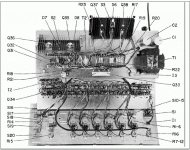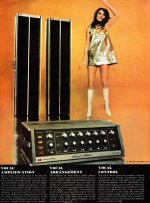I personally trust Panasonic, but Panasonic quality control may not be as stable as we would imagine. I know a music studio owner who was literally cursing Panasonic electrolytic caps. He recapped a vintage console with a thousand of Panasonic electrolytic caps, but after he finally powered up the console, he noticed some kind of bad chemical odor which appeared to be from Panasonic caps. Panasonic investigated the caps, and they admitted that the caps have manufacturing error, some chemical fluid remained between the label and body, and they sent him a thousand of replacement caps. He asked them to pay the labor re-replacing 1000 caps, but Panasonic denied his request, sorry... 🙁
All the FC's in my stock, dating back at least 10yrs have steel leads. All Elna Cerafine and Silmic have copper leads. But my Russian teflon K72's (one of the best caps I have) have thick steel leads and a thick steel case.
So does it really matter ?
So does it really matter ?
Well if they're iron based and non-magnetic they would have to be austenitic stainless steel (or similar), which really isn't any cheaper than copper.
No in the case of electrolytic caps it can be copper clad aluminium or the infamous Chinese "anymetal" (the lowest of low use this).
Real Panasonic FC caps have tinned iron/steel wires. I have seen fakes but I don't recall the wires. It is a pity that the datecode system at Panasonic is hard to decipher but I guess only very old stock could have tinned copper wires.
Last edited:
I have seen fakes but I don't recall the wires.
Perhaps you can distinguish the fakes by the telltale OFC copper terminations 😛
Ok got this back from Panasonic.
They no longer do any capacitors with non-magnetic leads.
"Yes, our capacitor leads are alloy of tin, copper and low carbon steel & is standard across our range of leaded capacitors.
I am not very confident on us having non-magnetic lead products; let me confirm and come back to you."
See ya later Pansonic.
Going to Nichicon from now on.
They no longer do any capacitors with non-magnetic leads.
"Yes, our capacitor leads are alloy of tin, copper and low carbon steel & is standard across our range of leaded capacitors.
I am not very confident on us having non-magnetic lead products; let me confirm and come back to you."
See ya later Pansonic.
Going to Nichicon from now on.
Anyone else noticed the change in color of the gold stripe marking the cathode? Not that it matters, but the newer ones seem to have a lighter color. If I hadn't bought mine from mouser, I'd have thunk they're fakes.
Perhaps you can distinguish the fakes by the telltale OFC copper terminations 😛
When I noticed fake Wima caps in a DAC and fake electrolytic caps with non magnetic wires I thought maybe older products that had tinned copper wires are simply rebranded. In the case of electrolytic caps it is just a new sleeve that is needed. Some can be recognised by looking at the pattern of the overpressure vent.
Nearly all manufacturers switched over to “mixed metal” wires. Panasonic FC and FM have ferro wires since many years. If one doesn’t notice it one Will notice eventually as the side cutter now wears out.
“For audio” caps still have tinned copper wires at some manufacturers. Snap in types are interesting as these often still have tinned copper lead wires internally going over in aluminium terminations. As these have better specs too I tend to choose these for PSU designs.
Last edited:
Are the FR for ferro ?🙄
Is there any chance some brands use low brass grade as well, or any mixture with low quantity of copper ?
Anyway for the FC, they are automotive grade and for my tastes far better than most Nichicons... YMMV of course ! Anyway the soldering ads something some can hear and it's worst for my ears than the leads composition...
Is there any chance some brands use low brass grade as well, or any mixture with low quantity of copper ?
Anyway for the FC, they are automotive grade and for my tastes far better than most Nichicons... YMMV of course ! Anyway the soldering ads something some can hear and it's worst for my ears than the leads composition...
I was told by Nichicon, all of the following have non-magnetic leads
UVY
UKW
UCM
UXY
UFW
UVK
UVR
UPW
UPS
UKA
UHE
UKT
UBY
UVZ
Edit: Actually this is not necessarily true. UBY have magnetic leads, I know this cause I have them.
I will query them on this.
UVY
UKW
UCM
UXY
UFW
UVK
UVR
UPW
UPS
UKA
UHE
UKT
UBY
UVZ
Edit: Actually this is not necessarily true. UBY have magnetic leads, I know this cause I have them.
I will query them on this.
Last edited:
Pretty sure I recall that the KW are magnetic.
Yeah, they could be.
I re-emphasized the need for non magnetic.
Hopefully have a new list soon.
Ok here it is
Nichicon have listed these as having non-magnetic lead wires.
"All the through hole types are magnetic, except series UKZ, UFG, UES and UDB."
Nichicon have listed these as having non-magnetic lead wires.
"All the through hole types are magnetic, except series UKZ, UFG, UES and UDB."
Nice to know for those who are iron intolerant so they can take adequate precautions, but practical fact is that iron path goes from a lot of aluminum foil wound inside the cap to nice wide copper tracks on the PCB or nice copper wire and net iron path length ends up being a couple mm.
At least for radial cap, the overwhelming type in use.
Unless it´s a true terminal strip PTP construction (haven´t seen many since the early 60´s) or an eyeletted board Fender amp, not really representative of amp construction for a few decades now.
Can´t believe such a tiny iron path can have any influence on sound.
Ok, an axial cap (not that popular these days) can add up to 5/10mm on each leg?
No big deal, I bet even Lab instruments can´t find any significant difference in amp performance and an impossible task for any ear involved.
On a double blind test at least.
Shure Vocal Master 1968, PTP built on terminal strips, a technique where parts lead length (and maybe material) is at least visible.
Not so sure about performance damaging.
Recommended period correct fashion for those who insist on PTP building on terminal strips.
At least for radial cap, the overwhelming type in use.
Unless it´s a true terminal strip PTP construction (haven´t seen many since the early 60´s) or an eyeletted board Fender amp, not really representative of amp construction for a few decades now.
Can´t believe such a tiny iron path can have any influence on sound.
Ok, an axial cap (not that popular these days) can add up to 5/10mm on each leg?
No big deal, I bet even Lab instruments can´t find any significant difference in amp performance and an impossible task for any ear involved.
On a double blind test at least.
Shure Vocal Master 1968, PTP built on terminal strips, a technique where parts lead length (and maybe material) is at least visible.
Not so sure about performance damaging.
Recommended period correct fashion for those who insist on PTP building on terminal strips.
Attachments
Last edited:
I am just curious, does the magnetic leads have any noticeable effect on audio?
No subjective opinion allowed in his thread. 😀
All bought from mouser/ farnell last twelve months, nichon mise and silmic non magnetic, nichicon pm Panasonic fc fm and fr all magnetic.
Ok got this back from Panasonic.
They no longer do any capacitors with non-magnetic leads.
"Yes, our capacitor leads are alloy of tin, copper and low carbon steel & is standard across our range of leaded capacitors.
I am not very confident on us having non-magnetic lead products; let me confirm and come back to you."
This is the response from Panasonic.
I must have got extremely lucky with the Panasonic FC caps I purchased previously, cause they no longer make any through hole capacitors with non-magnetic leads.
The snap-ins could be different though.
I think yes, if you know about it. 🙂I am just curious, does the magnetic leads have any noticeable effect on audio?
That's why, for example - I am happy with passives (resistors, caps) because I don't test them with a magnet. 🙂
Last edited:
- Home
- Design & Build
- Parts
- Panasonic FC caps have magnetic leads

